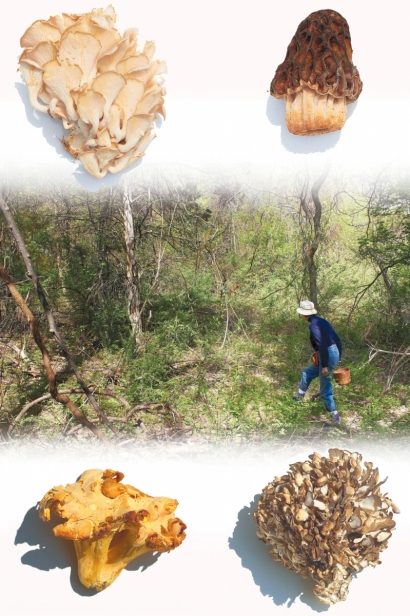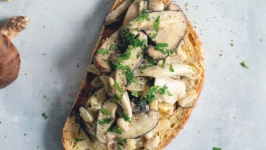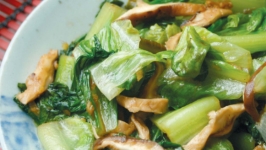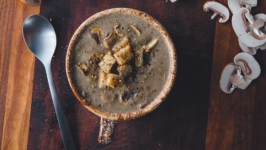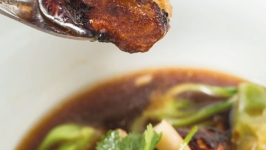From the Land: Mushroom Foraging
Walk on the Wild Side
Few things in life are as fiercely guarded as a forager's mine of wild morels. Chanterelles? They'd rather give you their computer passwords. Same with black trumpets, hen-of-the-woods, oyster, chicken and porcini mushrooms. As one wild mushroom forager whispered to me not long ago, "If I showed you where I hunt, I'd have to kill you." I'm still not convinced he was kidding. So when wild mushroomer Linda Manuel invited me to join her at one of her private preserves, I was surprised–and more than hesitant.
My fears, however, were unfounded. Manuel was nothing like the über fanatic I had envisioned. Instead, she was an exuberant exponent of anything and everything that had to do with wild mushrooms, from their taste–"simply divine"–to "the thrill of the hunt" to enticing newcomers like myself to the wild side of mushrooms. A delicate-boned yet strong woman, Manuel carries herself with the regal grace of Maria Callas. In fact, she once toured with the Metropolitan Opera's National Company, commanding standing ovations in lead roles in La Bohème and La Traviata. But now, a wild mushroom forager? Here, in Jersey? How did she step from the stage and into our woods, not to mention collect the wild mushrooms that local chefs and home cooks clamor for?
A FORAGER'S TALE
Easy, she says, as we sit at a table in the spacious kitchen of her Stockton home, a converted 19th-century barn she shares with Rocco, her three-year-old Maltese. "A friend was over and a neighbor asked him to help pick chanterelles so he could sell them. My friend declined, turning to me and saying we could go ourselves. That day [almost 30 years ago] we picked 25 pounds and sold them to La Bonne Auberge [the now-closed French restaurant in New Hope, Penn.]. I had so much fun, I wanted to learn more." And she did, reading everything she could about wild mushrooms, enrolling in botany classes, and joining the New Jersey Mycological Association to learn from experts about mushroom hunts, called forays. (Mycology is the study of mushrooms and fungi.)
When she found a good foraging spot, Manuel made note of it, telling no one of its location (perfectly acceptable behavior among mushroomers, where even best friends and lovers know not to ask). Often she'd bring specimens to class or forays, testing her knowledge and ensuring that what she had found was edible.
Manuel always evinced a fondness for good food, beginning as a child growing up in Michigan. "We had this marvelous cook, Ann Hamil [who] let me poke around in the kitchen. Before I was 9, I was making sherried mushrooms in cream." A trip to Paris with her mother when Manuel was 18 sealed her love of wild mushrooms, and later, while studying voice in Rome, she also trained her taste buds by expanding her culinary repertoire.
On the day of our meeting, Manuel was feeling optimistic. Heady from several successful days hunting for morels, she was hopeful of yet more. All depends on the weather, she says. Wild mushrooms like it wet, damp and dark. No rain means no mushrooms, she explains, pulling out a much-used black-and-white marble composition book from a nearby drawer and flipping through its pages. Each day she forages, Manuel records which mushrooms she's found, where she found them, and the day's temperature and weather in the book. "The weather tells me when to start looking and for what." Although New Jersey is home to a wide variety of wild mushrooms, it isn't just any edible mushrooms that she's after. Quality is an important consideration. "They have to be choice," says Manuel. "I only pick the top culinary mushrooms: morels, chanterelles, oyster, black trumpet, hen-of the-woods and chicken mushrooms. And of these, only the best specimens."
JEWELS OF THE FOREST
The where of mushroom foraging, says Manuel, is as critical as the what. Like creatures of habit, wild mushrooms appear in the same spots every year, with each preferring its own season. The seasonal crescendo of wild mushrooms begins with morels in the spring. Look for them around apple orchards, especially old ones, and mixed woods. Like strawberries, morels' window of availability is short, just two to four weeks. They resemble crinkly black honeycombs, and both the inside of their caps and their stems are white and hollow. Their flavor is intense–earthy and nutty. They don't need much dressing, Manuel says. Just sauté them in butter and some olive oil, then add lots of cream and a few shakes of salt and grindings of fresh pepper. Serve the mushrooms on toast or in omelettes, toss with pasta or add to risotto.
Next up in our region are golden chanterelles, a mushroom that writer Rowan Jacobsen describes in his 2010 book, American Terroir: Savoring the Flavors of Our Woods, Waters, and Fields, as "the Audrey Hepburn of mushrooms . . . its scent is beguiling and elusive." As with morels, Manuel advises the simplest recipes to showcase their flavor. A purist, she says," Wild mushrooms need very little done to them. No need for heavy sauces. It would be like putting ketchup on caviar. Why would you?"
Hen-of-the-woods, oyster, black trumpet and chicken mushrooms take us deeper into fall, with hen-of-the-woods, also called maitake, some of the fanciest. With "petals" that fan out like flowers or hen feathers, they're sometimes referred to as dancing mushrooms, especially in Japan, where folk legends tell of people dancing for joy when they found them. Hen-of-the-woods can also be some of the biggest, ranging in diameter from four inches to two feet, and can usually be found at the base of oak trees and stumps. Their intensely nutty, sweet flavor and chewy texture pair well with many dishes. Next time you're making cream of mushroom soup, use these beauties for a heavenly dish you'll want to make over and over. Or try a mix of wild mushrooms.
As their name suggests, chicken mushrooms, also called chicken-ofthe- woods, taste like their namesake. "You can use them instead of chicken in chicken salad–great for your vegetarian friends." Look for their bright orange fan- or shelf-like caps growing on logs. In contrast, oyster mushrooms are more chameleon-like, depending on your cooking choice, says Manuel. "If you cut them up and cook them in olive oil for a long time, they'll taste like bacon. If you want them to retain their fresh oyster aroma and taste, don't cook them very long."
Black trumpets, also called wood truffles, are many chefs' favorites for their flavor and texture, and are among the easiest to spot with their trumpet shape–although with their coloring, often mimicking dried twigs, they can elude the untrained eye. You'll find these culinary divas among deciduous trees, such as beech and oak.
A COOK'S GOLD
Never wash mushrooms, Manuel advises. If you do, you'll risk water-logging them and turning them mushy. Instead, she says, "just give them a shake." You can also go over them lightly with a dry brush or damp cloth. Another no-no is to eat wild mushrooms raw. Unlike the store-bought cultivated white, or button, mushrooms, which you can eat raw and are a favorite in salads, wild mushrooms require cooking.
All edible mushrooms have look-alikes that are poisonous, even deadly, says Manuel. "So never, ever, eat a mushroom unless you know without a doubt that it's edible." Manuel recommends the New Jersey Mycological Association as a good place to begin one's foraging, as well as reading books–"those with good illustrations and photographs. . . I know what is good and what is not, what is chancy and what is not. I don't take chances."
Chettie Errico, who runs the Chettie's Mushrooms stand at the Stockton Farmers' Market, specializes in wild and cultivated mushrooms, both local and from Oregon, Italy and France. For a man so young–just 19–he's well versed in the nuances of flavor and texture of every mushroom he sells. Not only can he tell you the mushroom's flavor profile, but how to clean and cook it and–if you tell him how you want to serve it and for how many–how much you'll need. Because of their intense flavor, he might tell you, you don't need much. And depending on the dish you have in mind, he might suggest trying different mushrooms together for a delectable variation.
"You can mix just about any of the mushrooms," says Errico. "But it's best not to pair powerfully-flavored, earthy ones, like hen-of-the-woods or black trumpets, with a milder mushroom for fear of canceling their distinct tastes." Of course, he says, if you want different textures then they'd work, like mixing the earthier hen-of-the-woods with the milder, meatier chicken mushroom.
Though all mushrooms have health benefits and are low in calories, hen-of-the-woods are among the best, Errico says, because they contain immune-system enhancers and cancer-preventing properties.
Errico is the son of Dawn McBeth, manager of the Stockton Farmers' Market; chef/owner of Ambrosia, a prepared foods emporium in the market; and a well-known advocate for local farmers and artisans. Before opening his stand, Errico conducted cooking demonstrations with Manuel's wild mushrooms at farmers' markets in New Hope and Wrightstown in Bucks County, Penn.
When wild mushroom season goes well, Manuel shows up at Errico's stand bearing her prize picks. And with her baskets of wild mushrooms, she's a welcome sight at area restaurants like The Cafe at Rosemont (in Rosemont); Nassau Street Seafood in Princeton; Rick's Restaurant in Lambertville; The Brothers Moon in Hopewell; Meil's, The Stockton Inn and Via Ponte, all in Stockton; and the Carversville Inn and the Black Bass Hotel in Bucks County.
I happened to be at Errico's stand shortly after Manuel had dropped off some sweet-looking morels. I carried home a bunch as if they were Cinderella's glass slippers–careful not to drop a one. When home, I gently wiped the outside of the morels with a damp paper towel, sliced them down the middle to check for unwanted tenants (there were none) and followed Manuel's directions for cooking. The plan was to eat some over crostini with a glass of Prosecco before dinner and keep the rest for tomorrow's omelette. Never having had morels, however, I thought it best to taste them before adding the cream. I should be embarrassed to tell you the morels never saw the cream nor made it out of the pan. But I'm not. I scooped up the last of them with chunks of crusty bread while still standing at the stove.
MAGIC AND MYSTIQUE
On my next visit with Manuel our talk turns to other reasons that drive her into the woods. From Shakespeare to Sondheim to John Muir, we humans have always been fascinated by the magic of the woods. Count mushroom foraging part of its magic. "It's just fun to see them growing," says Manuel. "They're so beautiful. Like licorice, you either like it or not. And then there's the quiet. Very peaceful . . . and you connect with nature . . . see baby foxes. Sometimes there are surprises–you never know what you'll find. Or maybe nothing– but that's part of the fun. Like going on a treasure hunt."
For Terri Layton, president of the New Jersey Mycological Association, it's mushroom memories that first attracted her to foraging for wild mushrooms. Growing up in Seoul, Korea, she holds fond memories of an aunt who lived in the country and shared her foraged mushrooms with Terri and her family: "I was fascinated that she could go out into the woods and bring back wonderful mushrooms for us to eat."
When Terri moved here, she naturally gravitated to the association to build on those memories and forge new ones. A diverse group of mushroom enthusiasts, the association attracts mathematicians, scientists, artists, photographers and foodies as well as recent immigrants and first-generation Americans. "We all learn from each other," Layton says.
Still it's the culinary magic that casts its spell over most. That's certainly true at The Cafe at Rosemont where Chef Lola Wykoff 's pasta with golden chanterelles is a much-anticipated menu favorite. Sharing her recipe, Wykoff says to sweat shallots in butter with a little olive oil and then toss in the cleaned chanterelles. "Cook the mushrooms until they're coated with the butter mix and until they become soft but not browned. Add lots of heavy cream, a dash of port and freshly grated nutmeg. I then turn the heat to medium-low and let the mushrooms and sauce cook until the wonderful aroma fills the kitchen." Don't worry about cooking the cream for so long, she says. "You can be a little cruel with cream." Toss the chanterelles and sauce with pasta (Wykoff prefers campanelle or farfalle for this dish). Grate Locatelli [pecorino romano] cheese over the pasta and more nutmeg on top. "Freshly grated nutmeg does wonders to all wild mushrooms," she says.
Wykoff adds this tip: Before tossing with pasta, lift some of the chanterelles out of the sauce with some cream still clinging to them; set aside to cool; and then refrigerate and use in the next day's omelette.
Says Will Mooney, chef/owner of The Brothers Moon restaurant in Hopewell and no neophyte to mushroom foraging, "There's more flavor to wild mushrooms as well as a bit of the mystique." Among Mooney's fall favorites are oyster, chicken and black trumpet. "I like to lightly grill chicken-of-the-woods, having first brushed them with olive oil and tossed with chopped garlic and perhaps some herbs, like thyme or rosemary, as well as salt and freshly ground black pepper." Perfect for an appetizer, he says, or add at the last minute to a risotto for a memorable wild mushroom experience.
Wild mushrooms are also a specialty of Alex Cormier, chef/owner of Rick's Restaurant in Lambertville. So popular are his wild mushroom dishes, a group of his regular customers asked him to create an all-wild-mushroom dinner for them this past summer–and he's planning more this season. His favorite for fall is the black trumpet. "I love the color and versatility of them," he says, "and black trumpets pair well with most shellfish and fish. They're so black and brilliant. I love serving black trumpets and lobster with a beurre blanc I make with the lobster roe–very classic French haute cuisine." The white of the lobster, the red of the butter and the black of the trumpets, he says, make for a very dramatic and delicious dish.
But, then, as Manuel says, "I don't think anything tastes as good as wild mushrooms. You can put them on anything–and it's just heaven." Manuel has promised to let me join her when she hunts for black trumpets at her secret spots this fall. Blindfold not required.
WORDS OF WARNING
Do not eat any mushroom unless you are absolutely sure it is safe! Mushrooms and false morels can contain toxins that are highly poisonous. If you have any uncertainty about the edibility of a mushroom, don't try it. If in doubt, throw it out!
While information about edible and poisonous mushroom is widely available in books and field guides and on the Internet, experienced foragers are the best resource. Forage with experts who can show you how to identify the important characteristics of edible and poisonous mushrooms.



